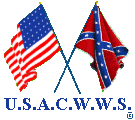
|
U. S. CIVIL WAR
PHOTOGRAPHS
|

|
CEDAR MOUNTAIN
(PAGE 2 OF 3)
| |
Confederate artillery firing from the mountain as well as from a small wooded
knoll known afterward as the Cedars, and from a gate where the Crittenden
 House lane met the main road, dueled with Union artillery posted on the Mitchell
Station Road. One Confederate thought the gunnery was "the prettiest artillery
duel ever witnessed during the war."
During the spectacular but inconclusive shelling both Stonewall Jackson and
division commander Brigadier General Charles S. Winder tried their hand as
gunners. Soon Winder was carried off of the battlefield mortally wounded
House lane met the main road, dueled with Union artillery posted on the Mitchell
Station Road. One Confederate thought the gunnery was "the prettiest artillery
duel ever witnessed during the war."
During the spectacular but inconclusive shelling both Stonewall Jackson and
division commander Brigadier General Charles S. Winder tried their hand as
gunners. Soon Winder was carried off of the battlefield mortally wounded when a Northern
shell tore away his side. when a Northern
shell tore away his side.
The battle entered its most furious phase shortly after 5 p.m. when the
Federal commander, Major General Nathaniel P. Banks, launched two
attacks against the Confederate line. Union infantry waded through a cornfield
heading for the Southern guns at the Cedars, while a second group of Northerners
advanced toward the guns planted by the Gate.

|

|

|
|
Nathaniel P. Banks
|
Samuel W. Crawford
|
Christopher C. Augur
|
Although outnumbered by Jackson's troops, Brigadier general Samuel W.
Crawford's Unionists struck Jackson's loosely-knit line near the Gate. Crawford
shattered Jackson's left after a desperate hand-to-hand combat that one veteran
remembered as "unsurpassed for ferocity by any other engagement during the war."
The Federals in the cornfield under Brigadier General Christopher C. Augur
billowed out of the corn
near the guns by the Cedars. out of the corn
near the guns by the Cedars.
The Confederate guns at the Gate, and the Cedars retreated while much of
their infantry support fled from the Union onslaught. Jackson rode into the
center of the storm waving his word with the scabbard still tightly rusted to it.
Defying fire from three sides, Jackson brandished his "sword" and a battle
flag, and banked on his name to rally the troops. One witness wrote later, "the
escape of Jackson from death was miraculous. He was in the thickest of the
combat, at very long range." The famed leader arrested the panic and restored
order. A.P. Hill's timely arrival established a stronger line and sent the
Federals reeling back across the fields. A small battalion of the
1st Pennsylvania Cavalry galloped into the teeth of the Confederate
counterattack to buy time for the retreating Federals. As darkness fell, Jackson
embarked on a concerted attack that swept Banks from the field. of the
1st Pennsylvania Cavalry galloped into the teeth of the Confederate
counterattack to buy time for the retreating Federals. As darkness fell, Jackson
embarked on a concerted attack that swept Banks from the field.
Jackson's 22,000 Confederates came dangerously close to defeat at the hands of
the Banks' inferior but aggressive force of about 12,000 Federals. Cedar
Mountain was the only battle in which Stonewall Jackson attempted to draw his
sword and lead his troops by example. Swayed by his personal involvement,
Jackson later asserted that Cedar Mountain was "the most successful of his
exploits."
Two days after the battle Jackson withdrew to meet Robert E. Lee, and begin
the campaign leading to the battle of Second Manassas and the demise of John Pope.
Once joined with Lee, Stonewall Jackson never again directed a campaign as an
independent commander.
(Text Source: U.S. Gov't, National Park Service)
 213 213
Federal battery fording a tributary of the Rappahannock River on
the day of battle.

Parson Slaughter's house on Slaughter's (or Cedar) Mountain.
Site of a Confederate battery. ["Slaughter Mountain" seems more appropriate -Ed]
|
|
CEDAR MOUNTAIN - PAGE 3
 >
Civil War Photos
>
Cedar Mountain
> Page 2
>
3
>
Civil War Photos
>
Cedar Mountain
> Page 2
>
3
Notes
|
|



